




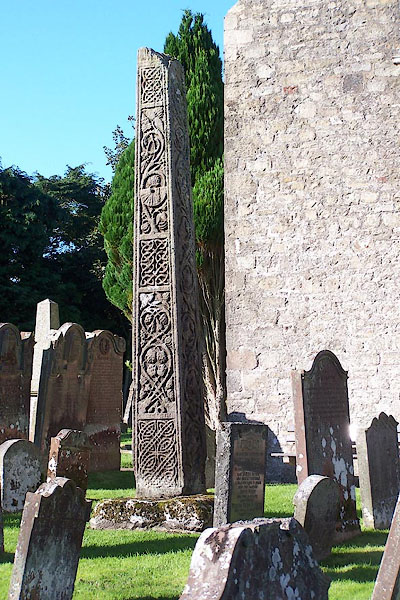
BMQ80.jpg (taken 15.9.2006)
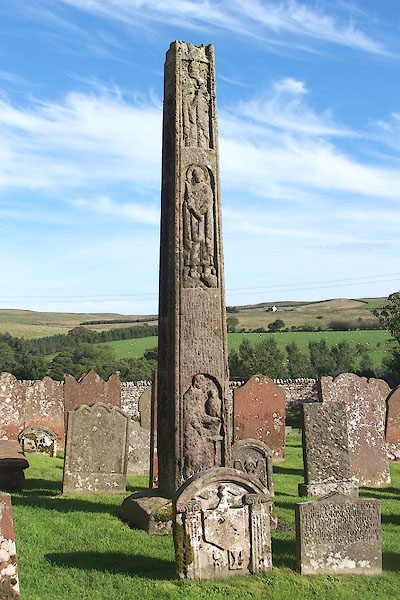
BMQ81.jpg (taken 15.9.2006)
"Cross"
 goto source
goto sourceGentleman's Magazine 1742 p.529
Print, uncoloured engraving, The South and East Prospects of the Famous Runic Obelisk at Bew Castle in Cumberland, by G Smith, engraved by W Pennock, published by the Gentleman's Magazine, London, 1742.
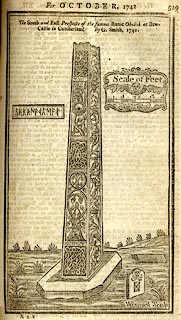 click to enlarge
click to enlargePR0717.jpg
"The South and East Prospects of the Famous Runic Obelisk at Bew-Castle in Cumberland. Taken by G. Smith, 1741."
Size: wxh, sheet = 13x21cm; wxh, image = 101x176mm.
item:- Armitt Library : Gents Mag 1742.3
Image © see bottom of page
 goto source
goto sourceGentleman's Magazine 1742 p.368 "The Explanation of the Runic Obelisk, (see p.318.) by George Smith, Esq;"
"SIR,"
"... Opposite to the Church Porch, at a few Yards Distance, stands the Obelisk, of one entire Stone, 15 Foot and a half high, springing through an Octagonal Pedestal, whose Sides were alternately equal. 'Tis nearly the Frustrum of a Square Pyramid, each Side being 2 Foot broad at Bottom, and one Foot and a half at Top, wherein a"
item:- runes
 goto source
goto sourceGentleman's Magazine 1742 p.369 "Cross was fixed, which has been demolished long ago, by popular Frenzy and Enthusiasm; and probably its Situation in these unfrequented Desarts has preserved the Remainder from their Fury."
"In the Bottom and Top Divisions, of the North Side, (see p.318) are cut Vine-Trees with Clusters of Grapes in Demi-relievo, probably the Danish Symbol of Fertility, as Amathea's Horn was amongst the Greeks."
"In a Fillet above the under Vine are these Characters fairly legible,"
 click to enlarge
click to enlargeG742E01.jpg
"which the learned Bishop Nicolson expounds RYNBURU, and thinks that it intimates the Expulsion of the magical Runae, and their Accession to Christianity. But if I may be allowed to dissent from so great a Name, I had rather believe it to be a Sepulchral Monument of one of the Danish Kings slain in Battle, and the Reading I think will support my Conjecture."
"For there is no Instance of any Nation using the 1st Character for an R, nor do I remember to have seen it so explained in all the numerous Runic Alphabets of Olaus Wormius, but the Danes about the Sinus Codanus, made Use of it for K. Besides the R is Roman wherever it occurs, in this and other Inscriptions on this Monument. The 2d is the Massagetic U a People about the Tanais. The next two Letters are wrong copy'd by the Bishop, the first is a Q, or Scythian N, the other an I; the 4 following are BURU plain; and the last is K Final, for the Initial and Final K differing in their Form was common in those Nations, as the Initial and Final M to the Hebrews. Upon the whole I read it KUNIBURUK, which in the old Danish Language imports Sepulchrum Regis. And the checquer Work included betwixt the two magical Knots (the Scythian Method of embellishing Funeral Monuments) very much corroborates my Opinion."
"However I so far agree with the Bp that it may also seem to have been designed for a standing Mounument of Conversion to Christianity, which might have happen'd on the Loss of their King, and each mutually celebrated by it."
"For Buchanan tells us, that in the Reign of Donaldus (the Sixth of that Name) the Danes having wasted Northumberland, were met and engag'd by the united Troops of England and Scotland, with such Uncertainty of Victory, that both Sides were equally glad of Peace, by which the Danes obliged themselves to embrace Christianity. This, therefore, was a very proper Monument for so great a Change; and the Figure on the West Side greatly contributes to favour this Conjecture, as I shall shew in my next Dissertation on the other three other Sides. This Transaction happened about 850 Years ago, and none believe the Obelisk to be older then 900."
"That the Monument is Danish appears incontestable from the Characters; Scottish and Pictish Monuments having nothing but Hieroglyphick's, and the Danish both; and, excepting Bride Kirk Font, it appears to be the only Monument of that Nation left in Britain. SIR,."
"Your very humble Servant,"
"GEO. SMITH."
 goto source
goto sourceGentleman's Magazine 1742 p.318
Print, uncoloured engraving, The North and West Prospects of the Famous Runic Obelisk at Bew Castle in Cumberland, by G Smith, engraved by Wennock, published by the Gentleman's Magazine, London, 1742.
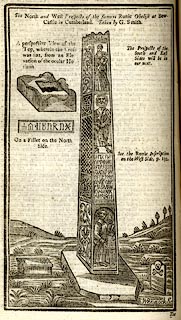 click to enlarge
click to enlargePR0715.jpg
"The North and West Prospects of the Famous Runic Obelisk at Bew-Castle in Cumberland. Taken by G. Smith."
Size: wxh, sheet = 13x21cm; wxh, image = 100x175mm.
item:- Armitt Library : Gents Mag 1742.1
Image © see bottom of page
item:- Magna Britannia Antiqua et Nova
 goto source
goto sourceGentleman's Magazine 1742 p.319
Print, uncoloured engraving, detail of the Bewcastle Cross, Cumberland, by G Smith, published by the Gentleman's Magazine, London, 1742.
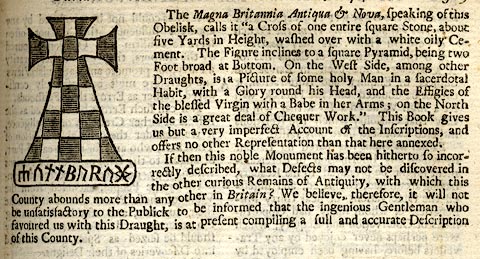 click to enlarge
click to enlargePR0716.jpg
Size: wxh, sheet = 13x21cm. "The Magna Britannia Antiqua &Nova, speaking of this Obelisk, calls it "a Cross of one entire square Stone, about five Yards in Height, washed over with a white oily Cement. The Figure inclines to a square Pyramid, being two Foot broad at Bottom. On the West Side, among other Draughts, is a picture of some holy Man in a sacerdotal Habit, with a Glory round his Head, and the Effigies of the blessed Virgin with a Babe in her Arms; on the North Side is a very great deal of Chequer Work." This Book gives us but a very imperfect Account of the Iinscriptions, and offers no other Representation than that here annexed."
"If then this noble Monument has been hitherto so incorrectly described, what Defects may not be discovered in the other curious Remains of Antiquity, with which this County abounds more than any other in Britain? We believe, therefore, it will not be unsatisfactory to the Publick to be informed that the ingenious Gentleman who favoured us with this Draught, is at present compiling a full and accurate Description of this County."
item:- Armitt Library : Gents Mag 1742.2
Image © see bottom of page
item:- runes
 goto source
goto sourceGentleman's Magazine 1742 p.132
Print, uncoloured engraving, runes on the Bewcastle Cross, Bewcastle, Cumberland, published by the Gentleman's Magazine, London, 1742. "We insert the following INSCRIPTION, not doubting that it will fall into the Hands of some Gentleman who understands the Language, and will please to give us the Explication. It is taken from a very curious Obelisk, erected for a Monument in a Church-yard in Cumberland."
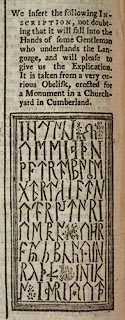 click to enlarge
click to enlargePR0718.jpg
item:- Armitt Library : Gents Mag 1742.4
Image © see bottom of page
item:- runes
 goto source
goto sourcePennant's Tour 1773, page 182 "In the church-yard is the celebrated Obelisk, carved with figures in good taste and great power of fancy. On it is a Runic inscription, which was copied by order of Lord William Howard, and sent to him by him to Sir Henry Spelman, who again communicated it to the learned Wormius. Wormius suspects it to have been incorrect, but ventures at this reading: RINO Lapides hos runicos posuit. - It is certainly of Danish origin, but the time and cause of its erection are quite unknown. Its height is fourteen feet two inches; its breadth on the bottom of the broadest side, one foot ten; of the narrowest side, one foot seven; on the top, one foot four."
 goto source
goto sourcePage 176:- "..."
"In the church-yard is a cross near 20 feet high, of one stone, neatly wrought, and having an inscription, but the letters too much consumed by time to be legible. But the cross itself being chequered like the arms of the family of Vaulx makes it probable that it was their work."
item:- runes; spells; charms
 goto source
goto sourcePage 200:- "..."
"No correct drawing has yet been made of the curious cross, whose inscription is in Runic characters. George Vertue shewed four to the Society of Antiquaries 1746, which I have not been able to recover. It is one entire square freestone about 15 feet high, washed over with a white oily cement: each side two feet broad at bottom tapering up. On the west side is a figure of a man with a hawk on his arm, and over him a long inscription, of which bishop Nicolson could find but six or seven lines, and only five letters visible; but Mr. Smith found nine lines with many well known Runic letters, and many characters not so intelligible, but equall perfect. On another side a figure of a saint or apostle with a nimbus, and above him the Virgin and child, both their heads in nimbi. On the north side is the chequer work, alluded to by Mr. Camden, and common on early crosses, and under it the fair characters engraved Pl.XIII. fig.1. Bishop Nicolson read this Rynburn, and explained it of the magical Runae or Ramruner, which Wormius and Arngrim Jonas say differed totally from the common Runic letters, and were much used as spells and charms, producing either good or ill effects according to the will of the parties who used them. Such charms appear to have obtained among the borderers so late as the close of the last century; a neighbouring gentleman having shewed the bishop a book of them taken out of the pocket of a moss trooper, containing, among other things, a certain remedy for the ague, by applying certain barbarous charms to the body. His lordship offers another explanation, making the 3d and 4th letter [ - runes] instead of [ - runes] which will make the reading Ryceburn in the old Danish, Coemiterium or Cadaverum sepulchrum. For though the true old Runic word for Cadaver be usually written [ - runes] Hrae, the H may be easily omitted, and then the difference of spelling the word here and on the monuments in Denmark will not be material. As to what he says of the "chequer work being a notable emblem of the tumuli or burying-places of the antients," it is not easy to understand him, and such an inscription on a cross in a church-yard would be superfluous. On the east are only flower-work, foliage, grapes and birds. On the south, flourishes and the inscription in Pl.XIII. fig.2. out of which, imperfect as it is, the bishop makes Gag Ubbo Erlat i.e. Latrones Ubbo vicit, confessing at the same time how little affinity this sense has with the foregoing, however agreeable to the manners of the people hereabouts both before and in his time. On the south side was also the inscription in Pl.XIII. fig.3. An inscription from this cross has been sent by Spelman from lord William Howard to Wormius, who published it in his Mon. Dan. p.162-168; see Pl.XIII. fig.4. which he reads thus, q.d. Reno satu Runa stiuod. i.e. Rino lapides hos Runicos fecit; but as he says, these were in epistylio crucis. When bishop Nicolson was here again on his visitation 1703, he tried to make out this on the west side; but though it promised fair at a distance he could not make out even this inscription. I take them to be those given on the head of the cross 1615, part of it now a grave-stone, though bishop Nicolson considers them as part of the ruins of the inscription over the head of the figure on the west side, plainly confounding the transverse piece of the cross with the upright of the cross itself. These make the 3d line fig.4 being copied from a slip of paper inserted in Mr. Camden's copy of his Britannia, ed.1607, in the Bodleian library before referred to, accompanied with the following note:"
""The imitation of the Pictishe stone taken out by impression or printing the paper within the very letters of the stoane. I receaved this morning a ston from my lord of Arundell, sent him from my lord William. It was the head of a cross at Bewcastle: all the letters legable ar ther on on line. And I have sett to them such as I can gather out of my alphabetts: that like an A I can find in non. But whither this may be only lettres or words I somewhat doubt." See the third line Pl.Xiii. fig.4."
 goto source
goto source"BEWCASTLE, ... in the church-yard is an ancient cross, on the sides of which are several sculptures, supposed to have been to the memory of some British or Scottish priest. ..."
 goto source
goto sourcePage 118:- "... Bewcastle, where are the ruins of an ancient castle, within a Roman encampment, and a very remarkable Runic pillar. ..."
 goto source
goto sourceGentleman's Magazine 1855 part 1 p.619
At a meeting of the Archaeological Institute. "... ..."
"The Rev. J. Maugham, of Bewcastle, sent careful drawings of the richly sculptured cross at that place, with a memoir on the Runes inscribed upon it, hitherto wholly unexplained, and now in great part legible through the results of an ingenious process long carried on under his care, in order to detach the lichens with which the stone is encrusted."
"... ..."
item:- runes; Long Bar, Bewcastle; Hewn Stone, Bewcastle
 goto source
goto sourceGentleman's Magazine 1856 part 1 p.407 "SOCIETY OF ANTIQUARIES, NEWCASTLE-UPON-TYNE."
"March 5. A paper was contributed by the Rev. Daniel H. Haigh, of Erdington, "On the Inscribed Cross at Bewcastle in Cumberland," - a four-sided column, about 141/2feet high, tapering gently from its base to the top. As a monument of our language, it is positively the very earliest we have of Anglo-Saxon times; and it belongs to a class of mounuments of which very few now remain - the memorials of the kings of England anterior to the Norman Conquest. Moreover, the inscription derives additinal interest from the fact that the king whom it commorates played a most important part in the ecclesiastical transactions of his age. In the inscriptions on the stone, the name of our Saviour, Jesus Christ, appears in a Latin form,"
"GESSUS
CRISTTVS"
"as it was only from missionaries, to whom the Latin language was as their mother tongue, that His name became known to our Saxon forefathers. The other inscriptions are in the early Saxon dialect of Northumbria. An inscription, in nine lines, on the western face, commemorates the personages to whose memory the monument was erected:-"
"+ THIS SIGBEC
VNSETTAE H
WAETRED EOM
GAER FLWOLD
V ROETBERT
YMB CYNING
A;CFRIDAE G
ICEGAED HE
OSVM SAWLVM"
"This inscription, like others of the same class and age, resolves itself into couplets of Alliterative verse, thus"
"This sigbecun
Settae Hwaetred
Eom gaer felwold
Ymb Roetbert
Ymb Cyning Alcfride
Gicegaed heosum sawlum."
"(This memorial set Hwaetred, in the great pestilence year, to Roetbert, to King Alcfride. Pray for their souls.) The letters LW in the fourth line may possibly be AEB. If so the meaning of EOM GAERFAE BOLD may be "also carved this building.""
"On the southern face these names occur each in a single line -"
"CRIST
EANFLAED CYNGN
ECGFRID CYNING CYNIBVRVG CYNGN
OSWV CYNING ELT"
"And on the following -"
"GESSV
OSLAAC CYNING
WILFRID PREAST R
CYNIBVRVG"
"Alchfrid was the eldest son of King Oswiu the Bretwalda, by his first wife Riemmelth the daughter of Rum - his second being Eanflaed, daughter of Edwin. While yet these inscriptions were a mystery, the tradition of the country, now confirmed, declared that a king was buried at Bewcastle. The same tradition points out the locality from which the stone was taken; and here, again, it is verified by a fact. On White Lyne Common, about five miles from Bewcastle, near the centre of a ridge of rocks called the Langbar, a stone is still lying, the very counterpart of of this monument, 15 feet in length, and of the same hard white freestone, marked with spots of grey, which is found at the Langbar, and the adjacent rocks on the south side of the White Lyne river, and in no other part of the district. This stone shows most distinctly, on its western side (which is much fresher than the others), the marks of the chisel which were used in splitting the block when the monument"
 goto source
goto sourceGentleman's Magazine 1856 part 1 p.408 "was taken from it which now stands in Bewcastle churchyard. (Rev. J. Maughan.)"
"Soon after their marriage, the "Alcfrith" and "Cyneburga" of the monument agreed to live together as brother and sister; and she gathered round her many young women, of noble as well as plebeian rank, who regarded her as their spiritual mother. "Oswu cyning elt" (Oswiu King the elder), father of Alcfrid, succeeded S. Oswald in 642. In many respects a good king, his memory is stained with the murder of S. Oswin, who had governed the provinceof Deira for seven yeras, in 650. By Oswiu's persuassions, Sigebert, King of the East Saxons, was converted to Christianity, and baptised at Walbottle, A.D. 654. "Eanflaed Cyngn," also named on the column, was the second wife of Oswiu, and the early patroness of St. Wilfrid - the "Wilfrid preaster" of the stone. "Ecgfrid cyning," son of Oswiu, appears to have borne the title of king in the lifetime of his father - to whose throne he succeeded in 670, and ruled one of the largest and most powerful kingdoms in the heptarchy. Of "Oslaac cyning," whose name is written on the monument, we have but one notice in history. Under the year 617, the Saxon Chronicle names him as an AEtheling driven out by Edwin, after his victory over Ethelfrid. Thus, as in a Saxon charter, after the act of donation, we have the names, in order of their dignity, of the witnesses thereto, so here, on the funeral monument of King Alcfrid, after the inscription to his memory, we have the names of those who, we may believe, assisted at his obsequies - his father Oswiu, his mother-in-law Queen Eanfled, his widow Cyneburga, his uncle Oslac, his brother Ecgfrid, and his chaplain Wilfrid, bishop-elect of York; and, above them all, the holy name of Jesus, reminding us of that beautiful prayer which is to be found in some ancient liturgies:- "Almighty and everlasting God, who hast created and redeemed us, mercifully regard our prayers, that, Thy grace being poured into our hearts, we may rejoice that our names are written in heaven beneath the glorious name of Jesus, the head of the book of eternal predestination, through the same Jesus Christ out Lord.""
"... ..."
item:- runes
 goto source
goto sourceGentleman's Magazine 1856 part 1 p.170 "... ..."
"Dr. Charlton then read a paper "On the Runic Inscription on the Cross at Bewcastle." This cross stands on the line of the celebrated Roman road, the Maiden Way, in the wastes of Cumberland, near the Borders, and is about 141/2 feet high, and 21 inches square at the base, tapering upwards to about 15 inches square at the top. At the summit is a socket in which a cross was doubtless placed. The pillar bears on its four faces various figures and ornaments (as may be seen engraved in Lyson's Cumberland), and also inscriptions in Runes. The first notice of this relic of antiquity appears in Camden, two centuries and a half ago; and various attempts have since been made, from time to time, to decipher the inscription - one of the latest being that of the zealous incumbent of Bewcastle, Mr. Maughan. Having, with great care, cleansed the stone of its lichens and moss, Mr. Maughan took careful casts of the characters, and communicated copies to several archaeologists; amogst others, to the Rev. Daniel Haigh, of Erdington, near Birmingham. On the north side of the cross is inscribed, very plainly, "Kyniburuk," or Cyneburg, the name of a queen of Northumbria, being the wife of Alchfrid son of Oswiu king of Northumberland. On the western face, the inscription, as deciphered, is - THIS SIGBECUN SETTAE HWAETRED, WITGAER, FELWOLD, &ROETBERT, UMAE KYNING ALCFRITHAE GEBIDAED HISSUM SAULA - intimating that the four persons first named had set up this cross to king Alcfrith, and requested prayers for his soul. Roetbert is commemorated in the Falstone inscription [Northumberland] as dead. Here he is named, with three other "thegns," as raising a stone to the memory of the good king Alcfrith, eldest son of Oswy, who succeeded St. Oswald, as king of Northumbria, in 643. Alcfrith, or Alchfrid, married Cyneburg, daughter of Penda, the pagan king of Mercia. Oswy and Alcfrid were zealous Christians; and to the influence of the latter was owing the conversion of Peada, son of Penda, and eventually that of the Mercians or Middle Angles. ... Not to follow Dr. Charlton into the controversies of Oswy and Alcfrid ... we return to the Runes. Mr. Haigh's interpretation of the inscription on the western face - (which, however, he gives subject to correction, his opinion being that the characters may not, all of them, have been accurately deciphered) - is remarkably confirmed by the occurence of Cyneburga on the cross, as read by Mr. Smith and others some years ago. On the south face is a Runic inscription, interpreted by Mr. Haigh - OSWU KYNING ELT - or Oswy the king. "Elt" may possibly refer to his being the elder (or head) of the family. This inscription confirms the supposition that the cross was reared in the lifetime of Oswy. No prayers being asked for the souls of Oswy and Cyneburga, as for the soul of Alcfrid, it may be inferred they are still living. If so, the memorial must have been erected between 644, when we last hear of Alchfrid, and 670, when Oswy died; and we have then a good date for fixing the age of the Falstone inscription, and of the many similar crosses which have escaped the ravages of time and man in the remote districts of Cumberland. In a note to his paper, Dr. Charlton refers to a new version of the Bewcastle inscription, published by Mr. Maughan in December, viz. - This sigbeacthon saetta Hwaetred, Withgar, Allewolthu, aft Alcfrithu, ean Kunig eak Oswiuing. Igebid heo sinna sawhual, i.e. "Hwaetred, Withgar, and Alfwold, erected this little beacon in memory of Alcfrid, at one time king with, and son of, Oswy. Pray for them, their sins and their soulds." The Doctor thinks the version of Mr. Haigh the more probable of the two, and nearer the truth."
"... ..."
 click to enlarge
click to enlargeHB0353.jpg
item:- Armitt Library : ALPS729
Image © see bottom of page
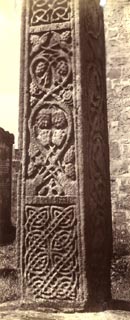 click to enlarge
click to enlargeHB0354.jpg
item:- Armitt Library : ALPS730
Image © see bottom of page
 click to enlarge
click to enlargeHB0361.jpg
item:- Armitt Library : ALPS739a
Image © see bottom of page
item:- cross; runes
 click to enlarge
click to enlargeCV1026.jpg
West side.
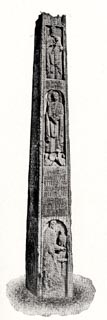 click to enlarge
click to enlargeCV1029.jpg
West side.
 click to enlarge
click to enlargeCV1027.jpg
South side.
Photographs by W Fletcher.
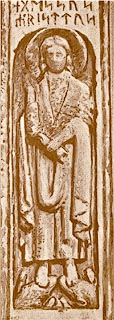 click to enlarge
click to enlargeCV1028.jpg
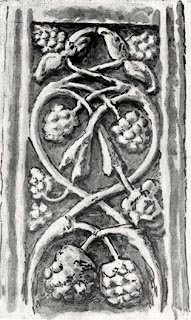 click to enlarge
click to enlargeCV1031.jpg
Sketches by W G Collingwood.
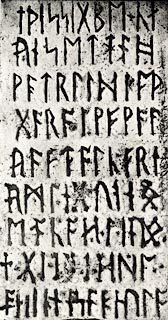 click to enlarge
click to enlargeCV1032.jpg
Tracing by W G Collingwood.
Mr Stephens, in Old-Northern Runic Monuments, reads:- "+ ThIS SIG-BECN / ThUN SETTON H- / WAETRED WOTh / GAR OLWFWOL- / ThU AFT ALCFRI- / ThU EAN KUNING / EAC OSWIUNG / + GEBID HE- / O . SINNA SAWHULA."
"This victory-column / thin set up / Hwaetred, Woth- / gar, Olwfwolthu / after Alcfrith / once king / and son of Oswi. / Pray for the high / sin of his soul."
item:- JandMN : 190
Image © see bottom of page
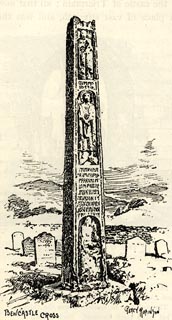 click to enlarge
click to enlargeBGG107.jpg
Included on p.46 of Lakeland and Ribblesdale, by Edmund Bogg.
item:- JandMN : 231.7
Image © see bottom of page
item:- religion
item:-
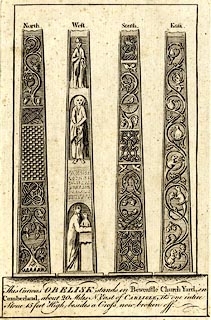 click to enlarge
click to enlargePR0510.jpg
N, W, S and E faces of Bewcastle Cross.
printed at bottom:- "This Curious OBELISK stands in Bewcastle Church Yard, in Cumberland, about 20 Miles N. East of CARLISLE, it's one intire Stone 15 feet High, besides a Cross now broken off."
item:- Dove Cottage : 2008.107.459
Image © see bottom of page
 sundial
sundial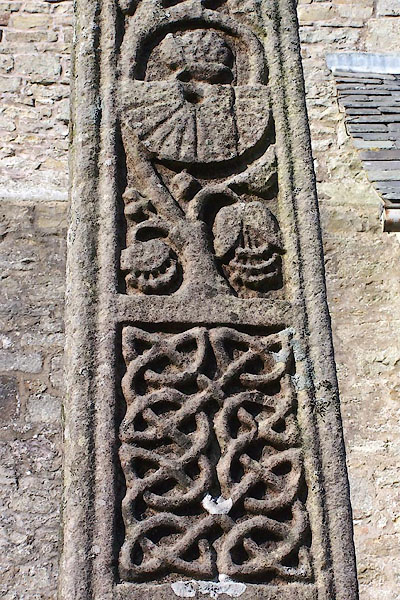
BMQ82.jpg (taken 15.9.2006)
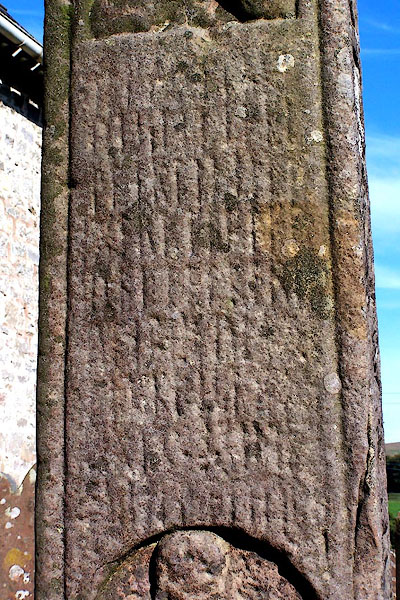
BMQ83.jpg Runic inscription.
(taken 15.9.2006)

BSE39.jpg (taken 19.2.2010)
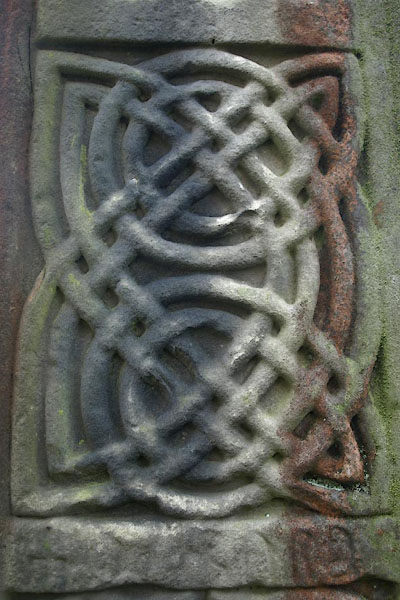
BSE40.jpg (taken 19.2.2010)
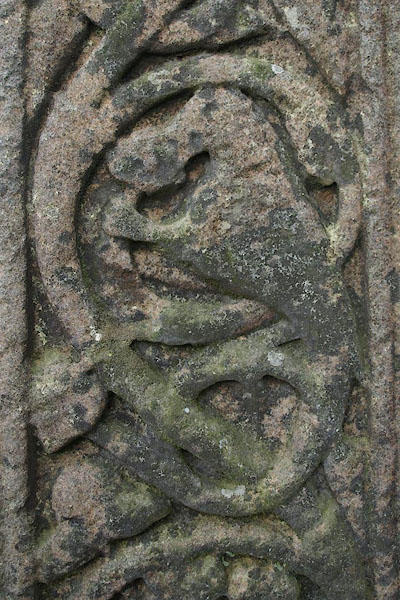
BSE41.jpg (taken 19.2.2010)
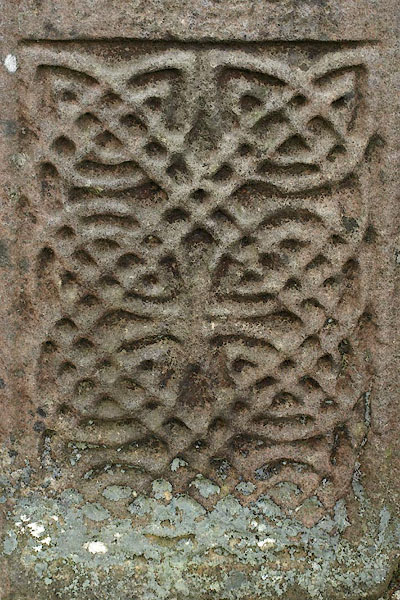
BSE42.jpg (taken 19.2.2010)
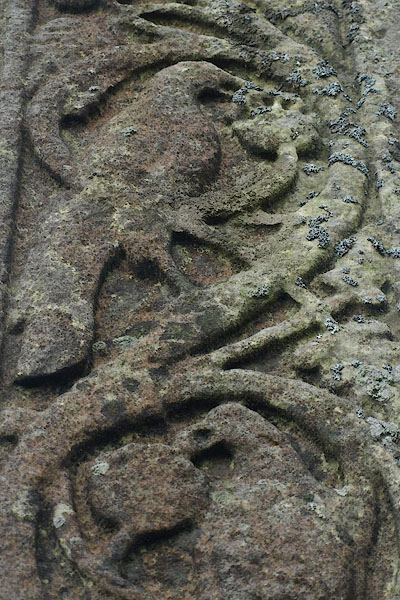
BSE44.jpg (taken 19.2.2010)
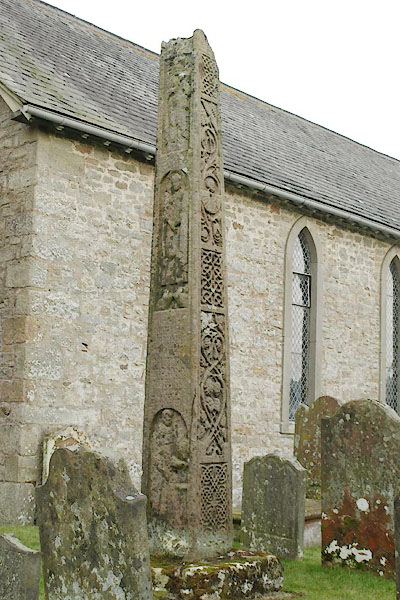
BSE45.jpg (taken 19.2.2010)
